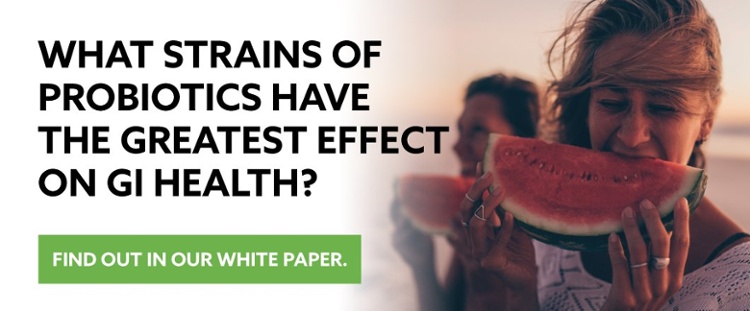
The microbiome plays a vital role in keeping us healthy by breaking down foods, producing hormones, and ultimately, keeping harmful organisms from taking over. Prebiotics and probiotics maintain the health of the microbiome, but what exactly do they do?
For decades, scientists have known about the symbiotic relationship between bacteria and humans, but it wasn’t until about 20 years ago that, as technology advanced, researchers gained more insight into the millions of microorganisms that live in our gut and make up the microbiome.
Before the advent of Western medicine, microbiomes were passed down from parent to child. But things in our modern world and food poisoning – which tend to kill off both good and bad bacteria indiscriminately—can disrupt the microbiome and may develop into gastrointestinal issues down the road.
You may have heard of prebiotics and probiotics, but do you know what roles they play in keeping your digestive health in check? Knowing the difference between prebiotics and probiotics is a vital step towards keeping your microbiome in a state of balance.
The Fundamental Difference
Prebiotics and probiotics are relatively new terms that describe the components needed to maintain or re-establish a healthy microbiome.
Prebiotics are nutrients that feed the various species of good bacteria that reside in your colon or large intestines. The group of beneficial, live bacteria that make up part of the dynamic and ever-changing landscape of the microbiome are called probiotics.
Prebiotics are foods that are high in fiber and act as fertilizer or compost that keeps your existing good bacteria alive and flourishing. Foods that are high in fiber are more difficult to break down naturally and can pass through the stomach and small intestines undigested. The prebiotic fiber goes through a fermentation process in the colon which is required to feed the majority of gut bacteria that reside there. Common prebiotic foods include bananas, onion, leeks, asparagus, garlic, nuts, and seeds.1
Probiotic foods are typically naturally fermented and include kimchi, sauerkraut, tempeh, kefir, yogurt, pickles, and miso. Since probiotic foods contain live bacteria, they are more sensitive to heat, time, and stomach acid. For probiotics to truly work, there must be a healthy nutrient-filled environment for them to take residence in and grow.2

When to Use Prebiotics and Why
Prebiotics should be taken when you want to promote the growth of healthy gut bacteria. Whether you’ve recently had an infection, experienced food poisoning, or have been keeping a poor diet, your gut bacteria may be thrown off balance.
Adding in probiotics to your diet without supplementing with prebiotics first is like trying to plant seeds in a garden without any fertilizer. You may see some growth, but without consistent nutrient support, the plants will die. Similarly, prebiotics and probiotics work synergistically to promote healthy gut bacterial growth.
How Do You Ensure Prebiotic Quality?
Since the majority of prebiotic foods are also high in undigestible fiber, it’s not uncommon for people to experience some irritation in the gut, especially if their GI system is already sensitive or irritated. Choosing foods that are organic and contain no pesticide or herbicide residue is a simple way to ensure that you are getting the highest quality of natural prebiotics.
High-quality supplements are another option if you’re looking for a convenient way to increase your probiotic fuel intake. Asking your healthcare provider for a recommendation may alleviate some of the stress in choosing a quality prebiotic and assure that what you’re taking is providing more benefits than harm.
When to Use Probiotics and Why
Probiotics, as with prebiotics, can be taken in situations where the good bacteria in the large intestines are wiped out. Since probiotics are live organisms, there are certain scenarios in which taking them will produce no significant benefit, such as if you’re experiencing issues with low hydrochloric acid or low digestive enzymes in the small intestines. It's when the bacteria in the large intestine or colon are thrown off that you see probiotics really shine and give their best efficacy.
How Do You Ensure Probiotic Quality?
While the majority of fermented probiotic foods taste sour, it’s important to note that not all pickled foods contain probiotic organisms. If you’re looking to add probiotic foods to your diet, knowing the difference between true fermentation and pickling is key.
In a true fermented pickle, sauerkraut, or kimchi, the sour taste comes from the bacteria that live in the salt brine environment, giving off lactic acid. For food to contain live probiotic organisms, it has to be in the refrigerated section, and the ingredients should list water, the vegetable, and then salt and spices—no vinegar.
Probiotic supplements are another widely available option, but as with prebiotic supplements, quality is key, as not all probiotics are made the same. Live bacteria must be present in a true probiotic for it to work, and the diversity of the bacteria is important as well.
Ongoing research on the human microbiome is paving an exciting new road that points to a synergistic relationship between the human body and the bacteria that live within it. Maintaining a healthy gut can be simple by making a few dietary changes to include a greater variety of foods. It’s important to know how these foods work together to keep our digestive system, as well as our entire bodies, functioning at their peak.
By Ian D. Bier, ND, PhD, LAc, FABNO

*These statements have not been evaluated by the Food and Drug Administration. This product is not intended to diagnose, treat, cure, or prevent any disease.
Sources:
1 “Prebiotics vs. Probiotics - Prebiotin.” 2018. https://www.prebiotin.com/prebiotin-academy/what-are-prebiotics/prebiotics-vs-probiotics/. Accessed January 16, 2020.
2 “Prebiotics vs. Probiotics - Prebiotin.” 2018. https://www.prebiotin.com/prebiotin-academy/what-are-prebiotics/prebiotics-vs-probiotics/. Accessed January 16, 2020.


















